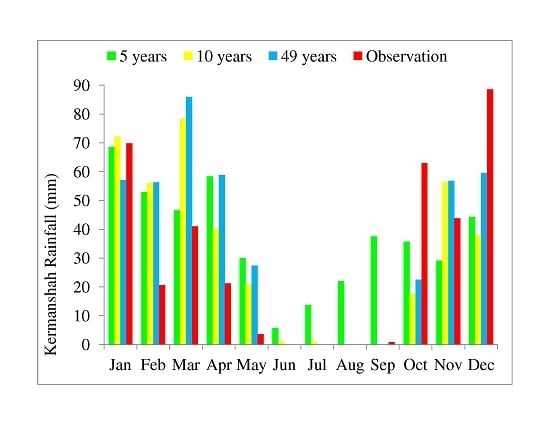How Much Meteorological Information Is Necessary to Achieve Reliable Accuracy for Rainfall Estimations?
Abstract
:1. Introduction
2. Material and Methods
3. Results and Discussion
4. Conclusions
- In temperate and semi-arid climates, 60 observation data is sufficient for the following year’s rainfall forecasting.
- The accuracy of the time series models increased with increasing amounts of observation data of arid and humid climates.
- Time series models are appropriate tools for forecasting monthly rainfall forecasting in semi-arid climates.
- Determining the most critical rainfall month in each climate condition for agriculture schedules is a recommended aim for future studies.
Conflicts of Interest
References
- Box, G.E.P.; Jenkins, G.M. Series Analysis Forecasting and Control; Prentice-Hall Inc.: London, UK, 1976. [Google Scholar]
- Khoshravesh, M.; Gholami Sefidkouhi, M.A.; Valipour, M. Estimation of reference evapotranspiration using multivariate fractional polynomial, Bayesian regression, and robust regression models in three arid environments. Appl. Water Sci. 2015. [Google Scholar] [CrossRef]
- Valipour, M.; Singh, V.P. Global Experiences on Wastewater Irrigation: Challenges and Prospects. In Balanced Urban Development: Options and Strategies for Liveable Cities; Maheshwari, B., Singh, V.P., Thoradeniya, B., Eds.; Springer: Bern, Switzerland, 2016; pp. 289–327. [Google Scholar]
- Valipour, M.; Gholami Sefidkouhi, M.A.; Raeini-Sarjaz, M. Selecting the best model to estimate potential evapotranspiration with respect to climate change and magnitudes of extreme events. Agric. Water Manag. 2017. [Google Scholar] [CrossRef]
- Valipour, M.; Gholami Sefidkouhi, M.A.; Khoshravesh, M. Estimation and trend evaluation of reference evapotranspiration in a humid region. Ital. J. Agrometeorol. 2017, in press. [Google Scholar]
- Valipour, M. Future of agricultural water management in Africa. Arch. Agron. Soil Sci. 2015, 61, 907–927. [Google Scholar] [CrossRef]
- Valipour, M. Calibration of mass transfer-based models to predict reference crop evapotranspiration. Appl. Water Sci. 2015. [Google Scholar] [CrossRef]
- Valipour, M. Analysis of potential evapotranspiration using limited weather data. Appl. Water Sci. 2015. [Google Scholar] [CrossRef]
- Valipour, M. Increasing irrigation efficiency by management strategies: Cutback and surge irrigation. ARPN J. Agric. Biol. Sci. 2013, 8, 35–43. [Google Scholar]
- Valipour, M. Necessity of Irrigated and Rainfed Agriculture in the World. Irrig. Drain. Syst. Eng. 2013, S9, e001. [Google Scholar] [CrossRef]
- Valipour, M. Evolution of Irrigation-Equipped Areas as Share of Cultivated Areas. Irrig. Drain. Syst. Eng. 2013, 2, e114. [Google Scholar] [CrossRef]
- Valipour, M. Use of surface water supply index to assessing of water resources management in Colorado and Oregon, US. Adv. Agric. Sci. Eng. Res. 2013, 3, 631–640. [Google Scholar]
- Valipour, M. Hydro-Module Determination for Vanaei Village in Eslam Abad Gharb, Iran. ARPN J. Agric. Biol. Sci. 2012, 7, 968–976. [Google Scholar]
- Valipour, M. Ability of Box–Jenkins Models to Estimate of Reference Potential Evapotranspiration (A Case Study: Mehrabad Synoptic Station, Tehran, Iran). IOSR J. Agric. Vet. Sci. 2012, 1, 1–11. [Google Scholar] [CrossRef]
- Valipour, M. A Comparison between Horizontal and Vertical Drainage Systems (Include Pipe Drainage, Open Ditch Drainage, and Pumped Wells) in Anisotropic Soils. IOSR J. Mech. Civil Eng. 2012, 4, 7–12. [Google Scholar] [CrossRef]
- Valipour, M. Application of new mass transfer formulae for computation of evapotranspiration. J. Appl. Water Eng. Res. 2014, 2, 33–46. [Google Scholar] [CrossRef]
- Valipour, M.; Montazar, A.A. An Evaluation of SWDC and WinSRFR Models to Optimize of Infiltration Parameters in Furrow Irrigation. Am. J. Sci. Res. 2012, 69, 128–142. [Google Scholar]
- Serinaldi, F.; Kilsb, C.G. A modular class of multisite monthly rainfall generators for water resource management and impact studies. J. Hydrol. 2012, 464, 528–540. [Google Scholar] [CrossRef]
- Luc, K.C.; Ball, J.E.; Sharma, A. An application of artificial neural networks for rainfall forecasting. Math. Comput. Model. 2001, 33, 683–693. [Google Scholar]
- Ludlow, J.; Enders, W. Estimating non-linear ARMA models using Fourier Coefficients. Int. J. Forecast. 2000, 16, 333–347. [Google Scholar] [CrossRef]
- Baareh, A.K.M.; Sheta, A.F.; Khnaifes, K.A. Forecasting River Flow in the USA: A Comparison between Auto Regressive and Neural Network Non-Parametric Models. J. Comput. Sci. 2006, 2, 775–780. [Google Scholar] [CrossRef]
- Mohammadi, K.; Eslami, H.R.; Dardashti, S.D. Comparison of Regression ARIMA and ANN Models for Reservoir Inflow Forecasting using Snowmelt Equivalent (A Case Study of Karaj). J. Agric. Sci. Technol. 2005, 7, 17–30. [Google Scholar]
- Mohammadi, K.; Eslami, H.R.; Kahawita, R. Parameter estimation of an ARMA model for river flow forecasting using goal programming. J. Hydrol. 2006, 331, 293–299. [Google Scholar] [CrossRef]
- Ramírez, M.C.V.; de Campos Velho, H.F.; Ferreira, N.J. Artificial neural network technique for rainfall forecasting applied to the São Paulo region. J. Hydrol. 2005, 301, 146–162. [Google Scholar] [CrossRef]
- Rezaei, M.; Valipour, M.; Valipur, M. Modelling evapotranspiration to increase the accuracy of the estimations based on the climatic parameters. Water Conserv. Sci. Eng. 2016. [Google Scholar] [CrossRef]
- See, L.; Abrahat, R.J. Multi-model data fusion for hydrological forecasting. Comput. Geosci. 2001, 27, 987–994. [Google Scholar] [CrossRef]
- Srinivas, V.V.; Srinivasan, K. Post-blackening approach for modeling dependent annual streamflows. J. Hydrol. 2000, 230, 86–126. [Google Scholar] [CrossRef]
- Toth, E.; Brath, A.; Montanari, A. Comparison of short-term rainfall predication models for real-time flood forecasting. J. Hydrol. 2000, 239, 132–147. [Google Scholar] [CrossRef]
- Valipour, M. Long-term runoff study using SARIMA and ARIMA models in the United States. Meteorol. Appl. 2015, 22, 592–598. [Google Scholar] [CrossRef]
- Valipour, M. Temperature analysis of reference evapotranspiration models. Meteorol. Appl. 2015, 22, 385–394. [Google Scholar] [CrossRef]
- Valipour, M. Use of average data of 181 synoptic stations for estimation of reference crop evapotranspiration by temperature-based methods. Water Resour. Manag. 2014, 28, 4237–4255. [Google Scholar] [CrossRef]
- Valipour, M. Evaluation of radiation methods to study potential evapotranspiration of 31 provinces. Meteorol. Atmos. Phys. 2015, 127, 289–303. [Google Scholar] [CrossRef]
- Valipour, M.; Eslamian, S. Analysis of potential evapotranspiration using 11 modified temperature-based models. Int. J. Hydrol. Sci. Technol. 2014, 4, 192–207. [Google Scholar] [CrossRef]
- Anctil, F.; Perrin, C.; Andréassian, V. Impact of the length of observed records on the performance of ANN and of conceptual parsimonious rainfall-runoff forecasting models. Environ. Model. Softw. 2004, 19, 357–368. [Google Scholar] [CrossRef]
- Andrieu, H.; French, M.N.; Thauvin, V.; Krajewski, W.F. Adaptation and application of a quantitative rainfall forecasting model in a mountainous region. J. Hydrol. 1996, 184, 243–259. [Google Scholar] [CrossRef]
- Balaguer, E.; Palomares, A.; Sorie, E.; Martin-Guerrero, J.D. Predicting service request in support centers based on nonlinear dynamics, ARMA modeling and neural networks. Expert Syst. Appl. 2008, 34, 665–672. [Google Scholar] [CrossRef]
- Burlando, C.; Rosso, R.; Cadavid, L.G.; Salas, J.D. Forecasting of short-term rainfall using ARMA models. J. Hydrol. 1993, 144, 193–211. [Google Scholar] [CrossRef]
- Chattopadhyay, S.; Chattopadhyay, G. Univariate modelling of summer-monsoon rainfall time series: Comparison between ARIMA and ARNN. C. R. Geosci. 2010, 342, 100–107. [Google Scholar] [CrossRef]
- Chenoweth, T.; Dowling, K.; Hubata, R.; Louis, R. Automatic ARMA identification using neural networks and the extended sample autocorrelation function: A reevaluation. Decis. Support Syst. 2004, 29, 21–30. [Google Scholar] [CrossRef]
- Chenoweth, T.; Dowling, K.; Hubata, R.; Louis, R. Distance and prediction error variance constraints for ARMA model portfolios. Int. J. Forecast. 2004, 20, 41–52. [Google Scholar] [CrossRef]
- Han, P.; Wang, P.X.; Zhang, S.Y.; Zhu, D.H. Drought forecasting based on the remote sensing data using ARIMA models. Math. Comput. Model. 2010, 51, 1398–1403. [Google Scholar] [CrossRef]
- Hu, W.; Tong, S.; Mengersen, K.; Oldenburg, B. Rainfall, mosquito density and the transmission of Ross River virus: A time-series forecasting model. Ecol. Model. 2006, 196, 505–514. [Google Scholar] [CrossRef]
- Jia, Y.; Culver, T.B. Bootstrapped artificial neural networks for synthetic flow generation with a small data sample. J. Hydrol. 2006, 331, 580–590. [Google Scholar] [CrossRef]
- Karamouz, M.; Araghinejad, S.H. Advance Hydrology; Amirkabir University of Technology Press: Tehran, Iran, 2012. [Google Scholar]
- Wei, C.; Hung, W.C.; Cheng, K.S. A multi-spectral spatial convolution approach of rainfall forecasting using weather satellite imagery. Adv. Space Res. 2006, 37, 747–753. [Google Scholar] [CrossRef]
- Xiong, L.; O’Connor, K.M. Comparison of four updating models for real-time river flow forecasting. Hydrol. Sci. J. 2002, 47, 621–639. [Google Scholar] [CrossRef]
- Yannopoulos, S.I.; Lyberatos, G.; Theodossiou, N.; Li, W.; Valipour, M.; Tamburrino, A.; Angelakis, A.N. Evolution of Water Lifting Devices (Pumps) over the Centuries Worldwide. Water 2015, 7, 5031–5060. [Google Scholar] [CrossRef]
- Yu, X.; Liong, S. Forecasting of hydrologic time series with ridge regression in feature space. J. Hydrol. 2006, 332, 290–302. [Google Scholar] [CrossRef]
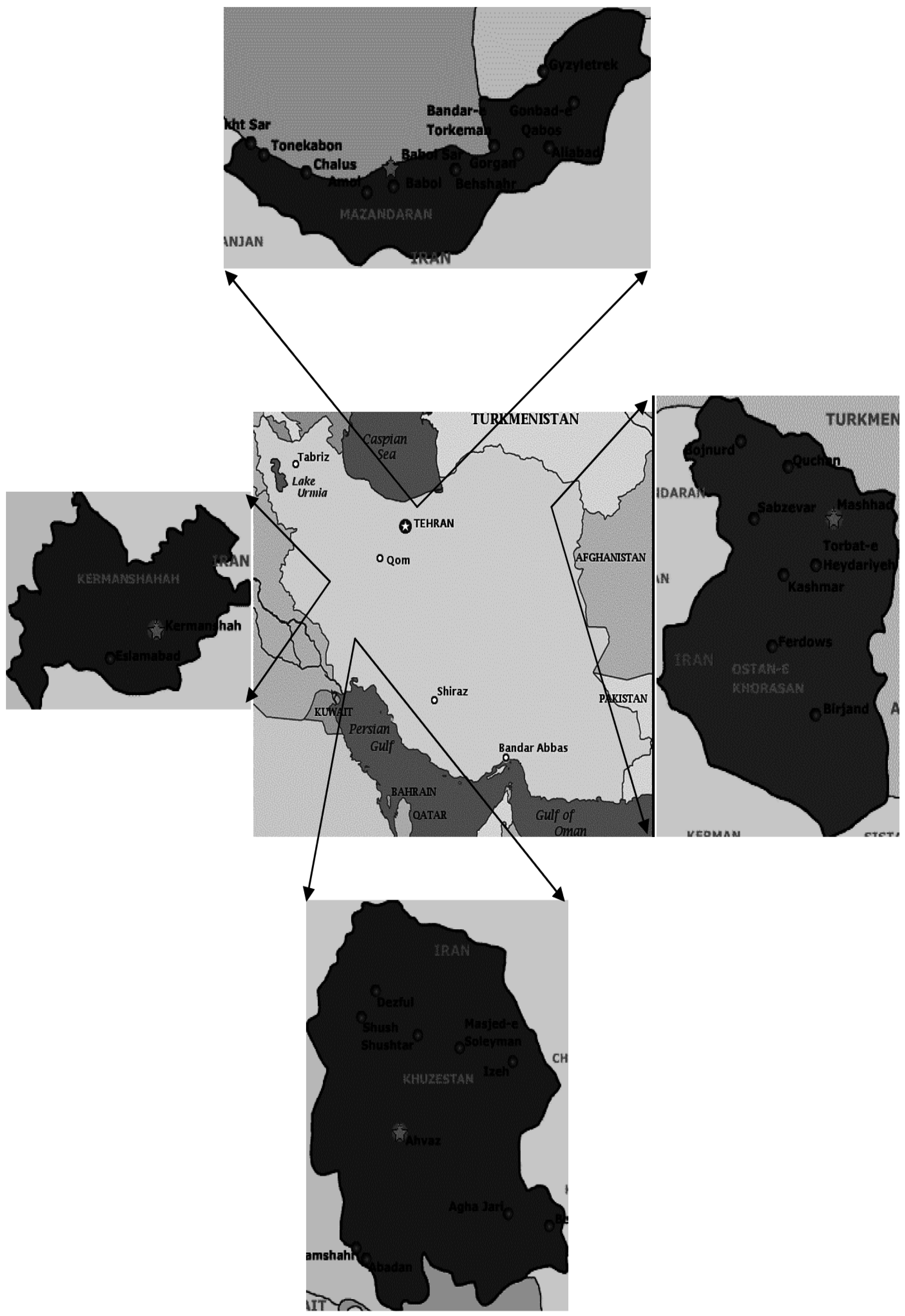
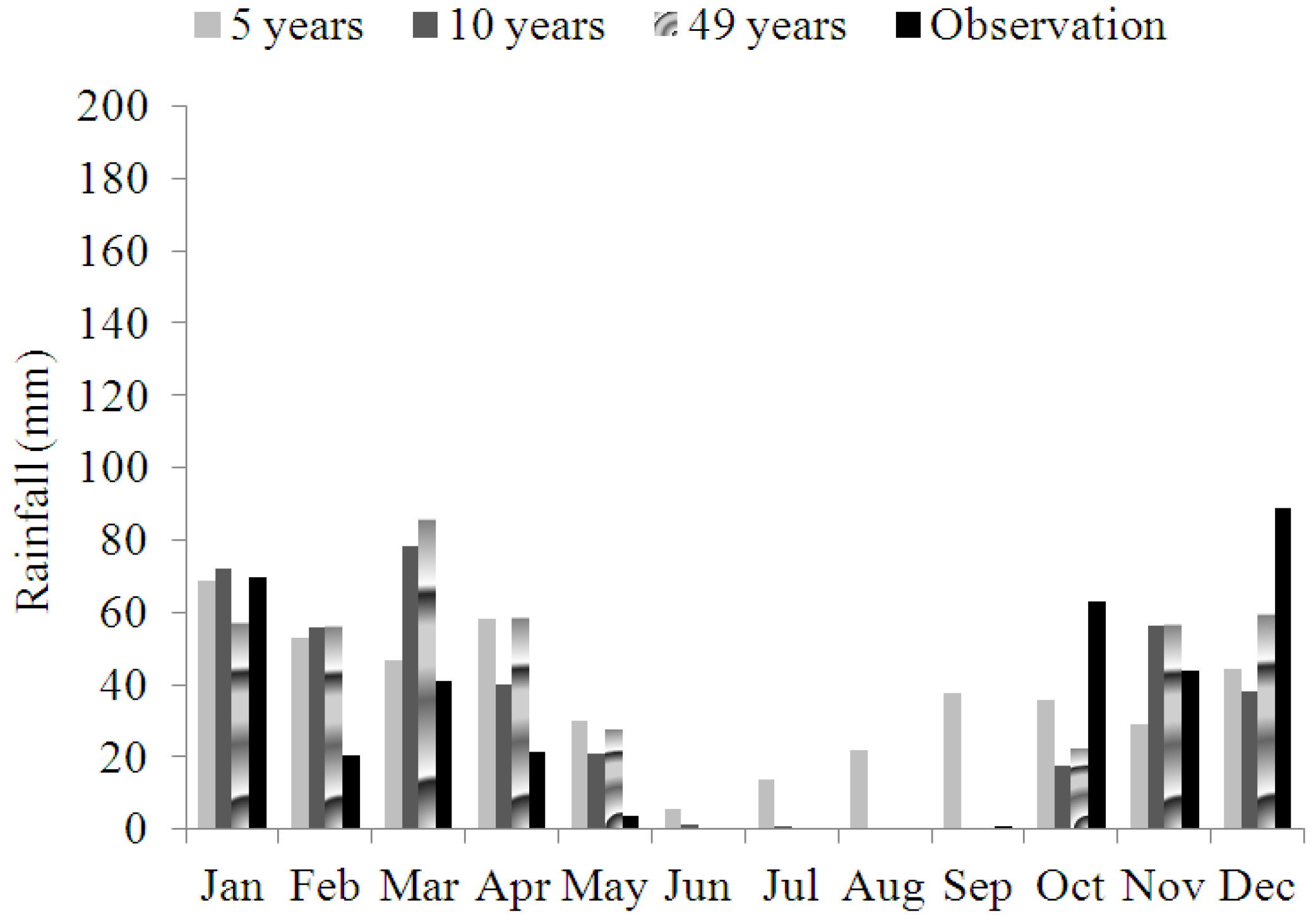
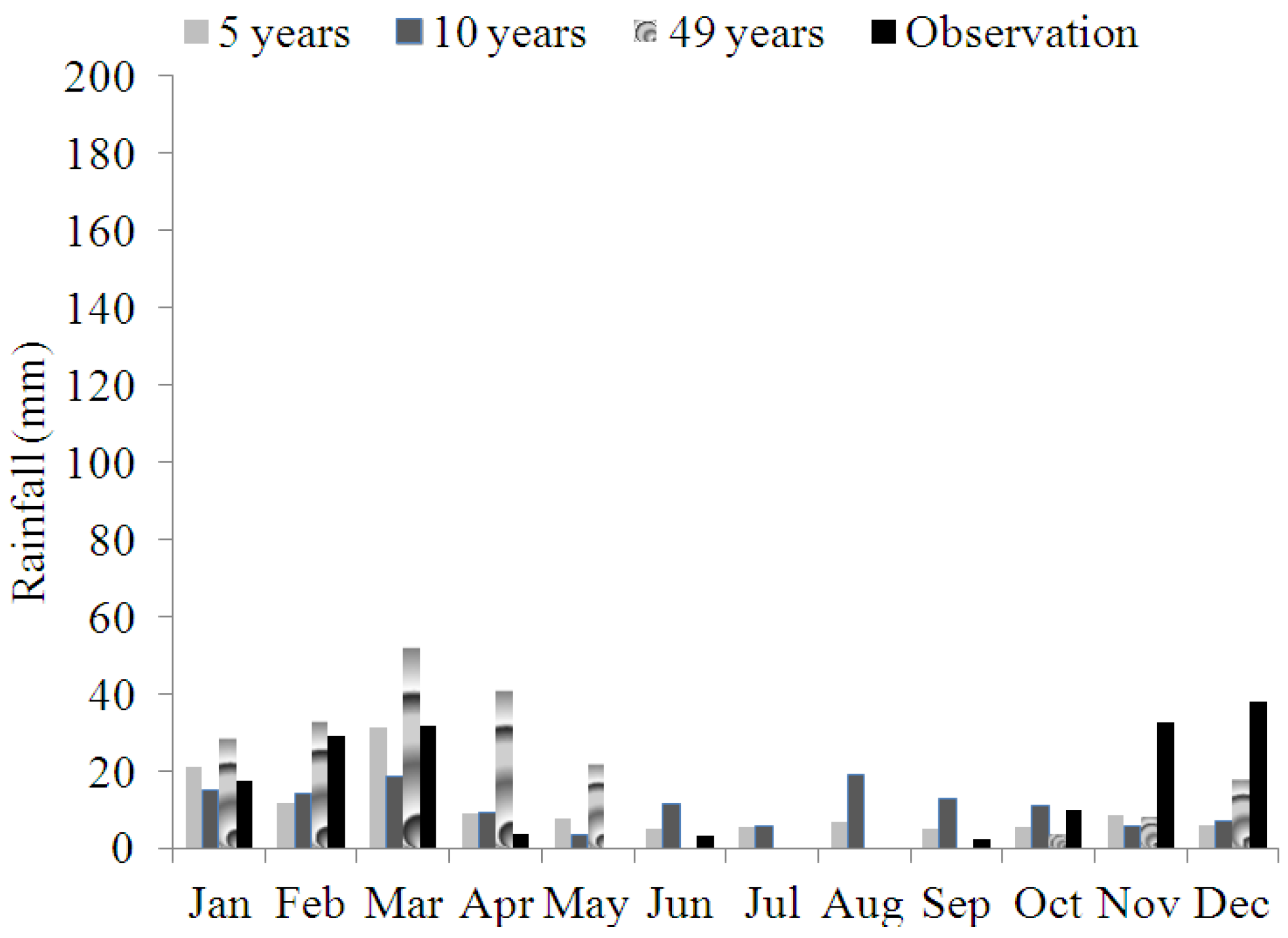
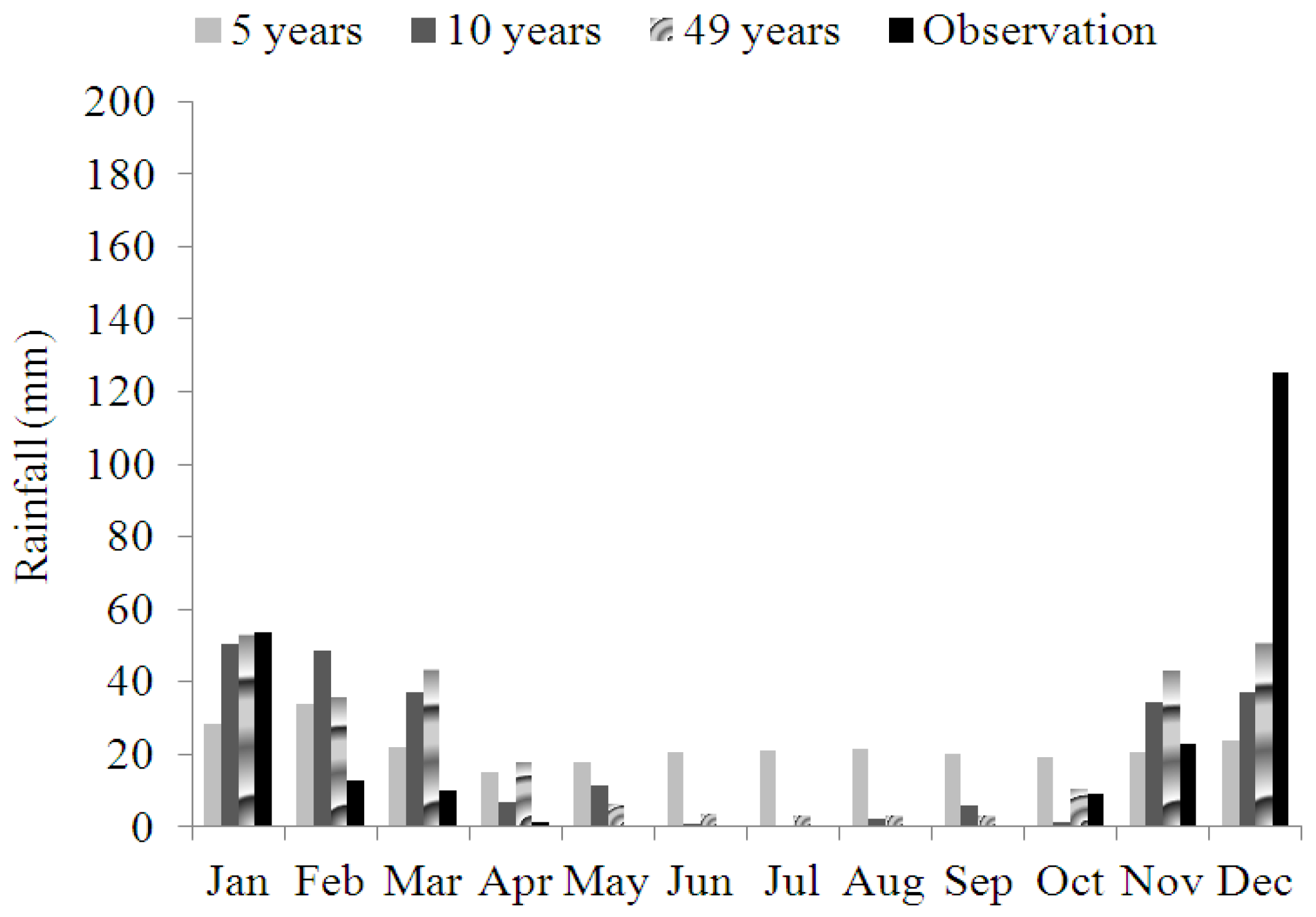
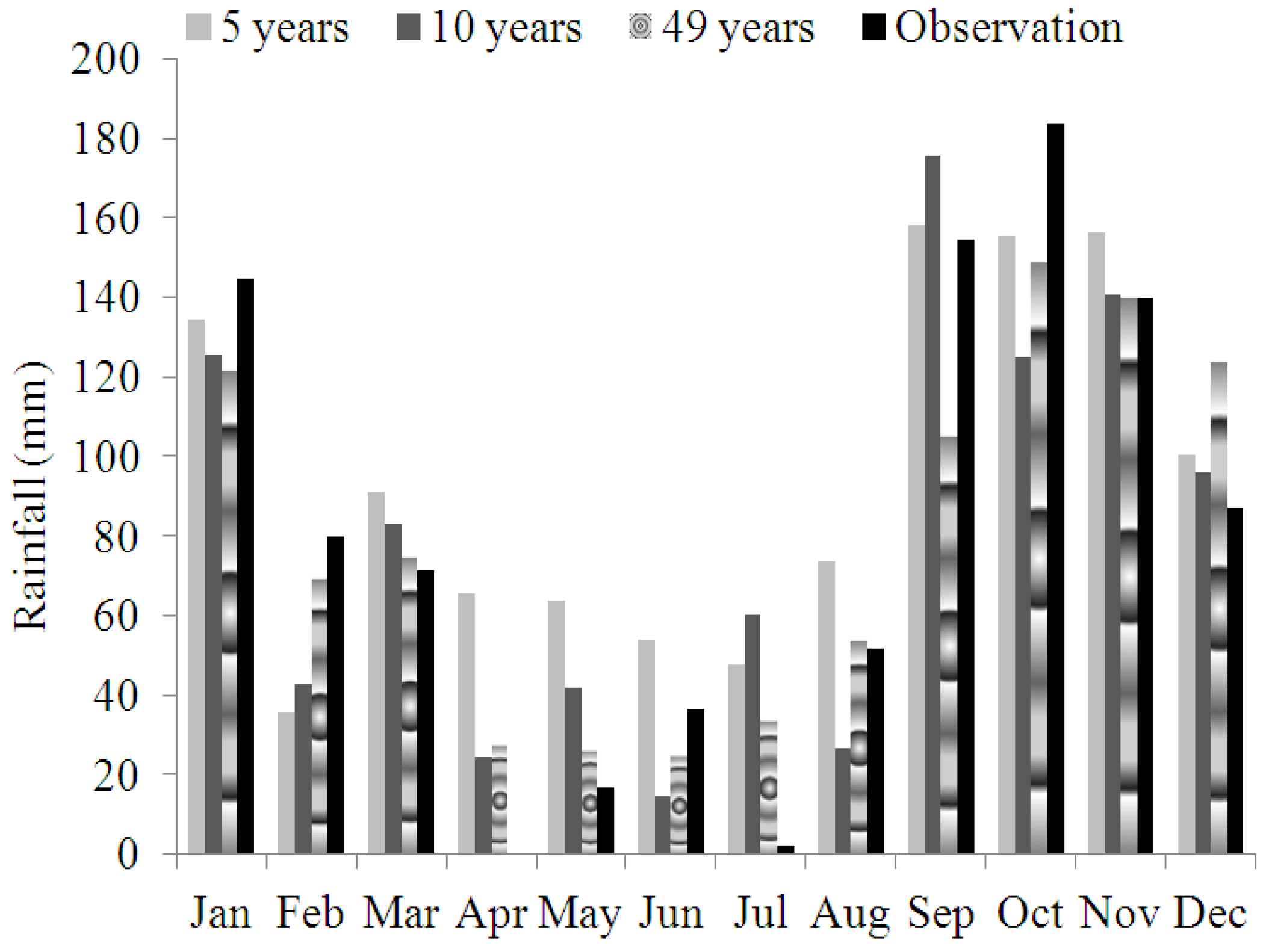
| Station | Climate | Elevation Related to Sea Level (m) | Longitude | Altitude |
|---|---|---|---|---|
| Kermanshah | Temperate | 999.2 | 59°38′ E | 36°16′ N |
| Mashhad | Semi-arid | 1322.0 | 47°7′ E | 34°17′ N |
| Ahvaz | Arid | 22.5 | 48°40′ E | 31°20′ N |
| Babolsar | Humid | −21.0 | 52°39′ E | 36°43′ N |
| Station | 5 Years (60 Data) | 10 Years (120 Data) | 49 Years (588 Data) |
|---|---|---|---|
| Kermanshah | 0.81 | 0.81 | 0.81 |
| Mashhad | 0.96 | 0.96 | 0.96 |
| Ahvaz | 0.77 | 0.83 | 0.87 |
| Babolsar | 0.70 | 0.73 | 0.82 |
© 2016 by the author; licensee MDPI, Basel, Switzerland. This article is an open access article distributed under the terms and conditions of the Creative Commons Attribution (CC-BY) license (http://creativecommons.org/licenses/by/4.0/).
Share and Cite
Valipour, M. How Much Meteorological Information Is Necessary to Achieve Reliable Accuracy for Rainfall Estimations? Agriculture 2016, 6, 53. https://doi.org/10.3390/agriculture6040053
Valipour M. How Much Meteorological Information Is Necessary to Achieve Reliable Accuracy for Rainfall Estimations? Agriculture. 2016; 6(4):53. https://doi.org/10.3390/agriculture6040053
Chicago/Turabian StyleValipour, Mohammad. 2016. "How Much Meteorological Information Is Necessary to Achieve Reliable Accuracy for Rainfall Estimations?" Agriculture 6, no. 4: 53. https://doi.org/10.3390/agriculture6040053
APA StyleValipour, M. (2016). How Much Meteorological Information Is Necessary to Achieve Reliable Accuracy for Rainfall Estimations? Agriculture, 6(4), 53. https://doi.org/10.3390/agriculture6040053




